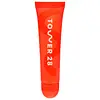What's inside
What's inside
 Key Ingredients
Key Ingredients

 Benefits
Benefits

 Concerns
Concerns

No concerns
 Ingredients Side-by-side
Ingredients Side-by-side

Hydrogenated Polyisobutene
EmollientPolybutene
Diisostearyl Malate
EmollientHydrogenated Soybean Oil
EmollientHydrogenated Olive Oil
Skin ConditioningPolyhydroxystearic Acid
EmulsifyingHydrogenated Jojoba Oil
AbrasiveEthylene/Propylene/Styrene Copolymer
Copernicia Cerifera Wax
Euphorbia Cerifera Wax
Lauroyl Lysine
Skin ConditioningButyrospermum Parkii Butter
Skin ConditioningRicinus Communis Seed Oil
MaskingCaprylyl Glycol
EmollientTocopherol
AntioxidantEthylhexylglycerin
Skin ConditioningPhytosterols
Skin ConditioningTocopheryl Acetate
AntioxidantButylene/Ethylene/Styrene Copolymer
Simmondsia Chinensis Seed Oil
EmollientGlycine Soja Oil
EmollientCocos Nucifera Oil
MaskingPentaerythrityl Tetra-Di-T-Butyl Hydroxyhydrocinnamate
AntioxidantAroma
Benzyl Alcohol
PerfumingBenzyl Benzoate
AntimicrobialIron Oxides
CI 15850
Cosmetic ColorantHydrogenated Polyisobutene, Polybutene, Diisostearyl Malate, Hydrogenated Soybean Oil, Hydrogenated Olive Oil, Polyhydroxystearic Acid, Hydrogenated Jojoba Oil, Ethylene/Propylene/Styrene Copolymer, Copernicia Cerifera Wax, Euphorbia Cerifera Wax, Lauroyl Lysine, Butyrospermum Parkii Butter, Ricinus Communis Seed Oil, Caprylyl Glycol, Tocopherol, Ethylhexylglycerin, Phytosterols, Tocopheryl Acetate, Butylene/Ethylene/Styrene Copolymer, Simmondsia Chinensis Seed Oil, Glycine Soja Oil, Cocos Nucifera Oil, Pentaerythrityl Tetra-Di-T-Butyl Hydroxyhydrocinnamate, Aroma, Benzyl Alcohol, Benzyl Benzoate, Iron Oxides, CI 15850
Diisostearyl Malate
EmollientCapryloyl Glycerin/Sebacic Acid Copolymer
Skin ConditioningBis-Diglyceryl Polyacyladipate-2
EmollientGlycerin
HumectantHydroxystearic/Linolenic/Oleic Polyglycerides
EmollientMyristic/Palmitic/Stearic/Ricinoleic/Eicosanedioic Glycerides
Skin ConditioningRicinus Communis Seed Oil
MaskingSqualane
EmollientWater
Skin ConditioningRosa Damascena Flower Wax
MaskingCeramide NP
Skin ConditioningHydrolyzed Jojoba Esters
Skin ConditioningVitis Vinifera Seed Oil
EmollientUndaria Pinnatifida Extract
Skin ConditioningCaprylic/Capric Triglyceride
MaskingTetrahexyldecyl Ascorbate
AntioxidantSodium Hyaluronate
HumectantJojoba Esters
EmollientTocopherol
AntioxidantHydrogenated Castor Oil
EmollientGlyceryl Caprylate
EmollientGlyceryl Undecylenate
EmollientDextrin Palmitate
EmulsifyingDiisostearyl Malate, Capryloyl Glycerin/Sebacic Acid Copolymer, Bis-Diglyceryl Polyacyladipate-2, Glycerin, Hydroxystearic/Linolenic/Oleic Polyglycerides, Myristic/Palmitic/Stearic/Ricinoleic/Eicosanedioic Glycerides, Ricinus Communis Seed Oil, Squalane, Water, Rosa Damascena Flower Wax, Ceramide NP, Hydrolyzed Jojoba Esters, Vitis Vinifera Seed Oil, Undaria Pinnatifida Extract, Caprylic/Capric Triglyceride, Tetrahexyldecyl Ascorbate, Sodium Hyaluronate, Jojoba Esters, Tocopherol, Hydrogenated Castor Oil, Glyceryl Caprylate, Glyceryl Undecylenate, Dextrin Palmitate
 Reviews
Reviews

Ingredients Explained
These ingredients are found in both products.
Ingredients higher up in an ingredient list are typically present in a larger amount.
Diisostearyl Malate is an emollient and most often used in lip products. It comes from isostearyl alcohol, a fatty acid, and malic acid, an AHA.
As an emollient, Diisostearyl Malate helps create a thin film on your skin to trap moisture in. This helps keep your skin soft and smooth.
Ricinus Communis Seed Oil is the INCI name for castor oil.
Castor Oil helps moisturize the skin. It is rich in a fatty acid called ricinoleic acid. This fatty acid helps prevent moisture loss on the skin. This helps keep your skin soft and hydrated. Ricinoleic acid also has anti-inflammatory and pain reducing properties.
Besides hydrating the skin, castor oil is also used to hydrate hair. By keeping the hair shaft moisturized, breakage is decreased. More studies are needed to show castor oil's effective on stimulating hair growth.
Castor oil is created by cold-pressing castor seeds and then purifying the oil with heat. It was used in Ancient Egypt as fuel in lamps and to help treat eye irritation.
The term 'fragrance' is not regulated in many countries. In many cases, it is up to the brand to define this term. For instance, many brands choose to label themselves as "fragrance-free" because they are not using synthetic fragrances. However, their products may still contain ingredients such as essential oils that are considered a fragrance.
Learn more about Ricinus Communis Seed OilTocopherol (also known as Vitamin E) is a common antioxidant used to help protect the skin from free-radicals and strengthen the skin barrier. It's also fat soluble - this means our skin is great at absorbing it.
Vitamin E also helps keep your natural skin lipids healthy. Your lipid skin barrier naturally consists of lipids, ceramides, and fatty acids. Vitamin E offers extra protection for your skin’s lipid barrier, keeping your skin healthy and nourished.
Another benefit is a bit of UV protection. Vitamin E helps reduce the damage caused by UVB rays. (It should not replace your sunscreen). Combining it with Vitamin C can decrease sunburned cells and hyperpigmentation after UV exposure.
You might have noticed Vitamin E + C often paired together. This is because it is great at stabilizing Vitamin C. Using the two together helps increase the effectiveness of both ingredients.
There are often claims that Vitamin E can reduce/prevent scarring, but these claims haven't been confirmed by scientific research.
Learn more about Tocopherol